

Conduire le changement et accompagner le déploiement de l’ENT dans son établissement. Hal.archives-ouvertes.fr/docs/00/72/70/19/PDF/Rapport_Eval_EAD_UdS_2012-09-01.pdf. Présentiel allégé. Project-Based Learning. Lada Adamic: University of Michigan. Www.cnil.fr/fileadmin/documents/Guides_pratiques/CNIL_Guide_enseignement.pdf. What is methodology? As social science researchers, we would all like to have an excellent methodology for carrying out the tasks we confront in our scientific work.
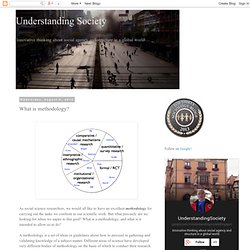
But what precisely are we looking for when we aspire to this goal? What is a methodology, and what is it intended to allow us to do? A methodology is a set of ideas or guidelines about how to proceed in gathering and validating knowledge of a subject matter. Different areas of science have developed very different bodies of methodology on the basis of which to conduct their research. We might say that a methodology provides a guide for carrying out some or all of the following activities: Social scientists have a number of methods, stylized ways of conducting their research that comprise routine and accepted procedures for doing the rigorous side of science. Connecting the Dots: Researcher Positionality in Participant Observation.
Aaminah Norris Editor’s Note: Aaminah Norris (@aaminahm) is just about to finish her PhD in the Graduate School of Education at UC Berkeley.
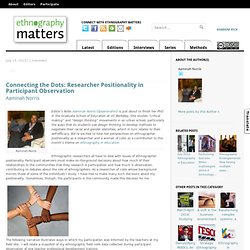
She studies “critical making” and “design thinking” movements in an urban school, particularly the ways that its students use design thinking to develop methods to negotiate their racial and gender identities, which in turn relates to their self-efficacy. We’re excited to hear her perspectives on ethnographer positionality as a researcher and a woman of color as a contribution to this month’s theme on ethnography in education.
Ethnographic researchers all have to deal with issues of ethnographer positionality. Participant observers must make on-the-ground decisions about how much of their relationships to the communities that they research is participation and how much is observation, contributing to debates about the role of ethnographers. This particular design training was on diversity, and took place over the course of two days. Then Ms. Alternatives to pies. My disdain for pie charts is well documented.

While opinions on their usefulness run the gamut, I am certainly not alone in my contempt. In my workshops, I sometimes get the question, "In what situation would you recommend a pie chart? " For me, the answer is never.* There are a number of alternatives, each with their own benefits. It's these alternatives that I'll focus on in this post. *Full disclosure: There was once a situation at Google where we wanted to share some diversity stats on gender breakdown but didn't want to show the specific values. I believe the above data demonstrates that, on the basis of improved sentiment towards science, the pilot program was a great success. The above visual does this story a great disservice. Let's take a look at four alternatives using the above data. Alternative #1: Show the Number(s) Directly If the improvement in positive sentiment is the big thing we want to communicate, we can consider making that the only thing we communicate:
Www.sagepub.com/upm-data/43465_Booth_et_al.pdf. Www.sagepub.com/upm-data/58106_Kiteley_&_Stogdon.pdf. Www.sagepub.com/upm-data/28728_LitReview___hart_chapter_1.pdf. Which social media network type is your topic? Which did you want it to be? April 15th, 2014 by Marc Smith · 13 Comments There are at least six different types of social media network structures present in systems like Twitter and other services in which people are able to reply to one another.
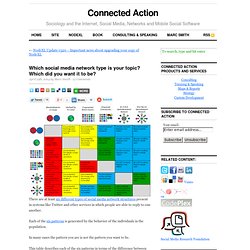
Each of the six patterns is generated by the behavior of the individuals in the population. In many cases the pattern you are is not the pattern you want to be. This table describes each of the six patterns in terms of the difference between that pattern and the other five patterns. Go down the rows until you find the pattern that most closely matches the network you currently have. At the intersection is a color and a few ways to change and measure the transition from where you are to where you want to be. Language & Cognitive Architecture Lab, University of Michigan. We are developing theories of the mental architecture that supports language processing—especially the short-term memory system that allows us to keep in mind and revise the partial interpretation (or generation) of earlier parts of a sentence while relating it to the rest.

Our recent work advances and empirically defends (through detailed cross-linguistic studies of reading, including eye-tracking) a number of specific hypotheses about the principles that govern how this memory system works. A key feature of this work is that the proposed principles—such as similarity-based interference and a sharply limited focus—are general ones that have broad explanatory power in domains outside of sentence processing.
Revue sticef.org. André Tricot, Fabienne Plégat-Soutjis IUFM de Midi-Pyrénées 1.
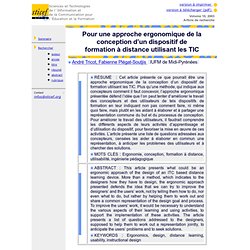
Introduction La littérature sur l’ingénierie pédagogique ou le instructional design est immense (8348 documents sur la base Educational Resources Information Centrer – ERIC – en juillet 2003). Même une librairie en ligne généraliste comme AMAZON référence plus de 40 ouvrages sur le thème. Comment améliorer le processus de conception ? 1.1. Méthodes et outils de résolution de problèmes. En matière de résolution de problèmes il faut distinguer les méthodes structurées qui permettent de cerner et résoudre un problème et les outils spécifiques mis en œuvre au sein de la méthode.

Les méthodes - PDCA - DMAIC - Rapport A3 - 8D - QRQC - CARRE D'ASLes outils de résolution de problèmes - 5 pourquoi (video)Les Thinking Processes (pour problèmes complexes)S'assurer de la résolution du problème et de la durabilité de la solution avec QOS (Quality Operating System) Toutes les méthodes de résolution de problèmes s’articulent autour d’un nombre variable de phases ou d’étapes, parmi lesquelles comptent quatre incontournables qui peuvent se rapporter au rustique et très robuste PDCA. PDCA est formé des initiales des verbes d’action Planifier, Déployer, Contrôler, Ajuster ou Plan, Do, Check, Act en anglais. Research.ncl.ac.uk/forum/v8i1/distance learning.pdf. Lateral Thinking. Edward de Bono has written extensively about the process of lateral thinking -- the generation of novel solutions to problems.
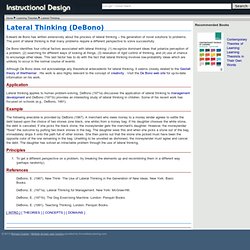
The point of lateral thinking is that many problems require a different perspective to solve successfully. De Bono identifies four critical factors associated with lateral thinking: (1) recognize dominant ideas that polarize perception of a problem, (2) searching for different ways of looking at things, (3) relaxation of rigid control of thinking, and (4) use of chance to encourage other ideas.
This last factor has to do with the fact that lateral thinking involves low-probability ideas which are unlikely to occur in the normal course of events. Although De Bono does not acknowledge any theoretical antecedents for lateral thinking, it seems closely related to the Gestalt theory of Wertheimer . His work is also highly relevant to the concept of creativity . Série d’été. Discours et mémoire. La mémoire est l’une des questions les plus intéressantes en analyse du discours, elle a été beaucoup travaillée et retravaillée en France et au Brésil depuis les années 1980, à partir de “l’invention” de Jean-Jacques Courtine : la notion de “mémoire discursive”, dans la thèse qu’il a rédigée sous la direction de Michel Pêcheux, et publiée dans un numéro de Langages devenu classique (Courtine 1981).

Dans une conversation avec M., récemment, j’ai vu émerger les questions qui m’ont fascinée moi aussi quand je me suis plongée dans ces travaux pour écrire Les prédiscours (Chapitre 3. “La mémoire en discours”, 2006), et que j’ai remises au travail récemment dans Langage et morale (Chapitre 6. Créer des flux RSS Twitter avec la nouvelle API 1.1. Comme vous devez le savoir, Twitter a décidé de ne plus rendre disponibles les flux RSS dans sa nouvelle API 1.1.

Voici une méthode (un script) pour continuer à s’abonner à des comptes, listes ou recherches Twitter via la technologie RSS. 1. Créer une application Twitter - Se rendre ici et créer une application avec le nom, la description et le site de votre choix (cela n’a pas vraiment d’importance). - Ajouter cette URL dans la ligne CallBack URL : 2. Ajouter le script - Cliquez ici pour ajouter le script à votre Google Drive - Inscrire les données Twitter Consumer Key et Twitter Consumer Secret dans la start() function (et uniquement dans celle-ci) - Cliquez sur Fichier –> Gérer les versions –> Enregistrer une nouvelle version (et lui donner un nom bidon) - Cliquez sur Publier –> Déployer en tant qu’application Web et choisir un accès à tout le monde, même les utilisateurs anonymes.
Isomorphisme, cohérence et variété ... vers une systémique de la technopédagogie ? CENTRE DOCUMENTAIRE - institut supérieur de pédagogie faculté d'éducation. Www.e-doceo.net/telechargement/classification-elearning-e2c-fr.pdf. Lexique bilingue des media sociaux — Enseigner avec le numérique. Ressources en accès libre. Réaliser son site web. Lodel, logiciel d'édition électronique. Reseau Langage & Travail. • Anni BORZEIX a publié - BORZEIX A., 1987. "Ce que parler peut faire", Sociologie du travail, n° 2.